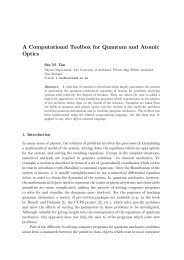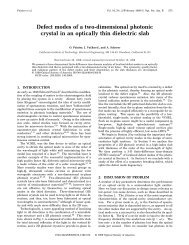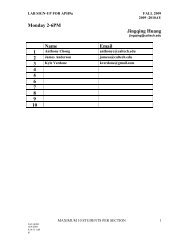A Quantum Optics Toolbox for Matlab 5
A Quantum Optics Toolbox for Matlab 5
A Quantum Optics Toolbox for Matlab 5
- No tags were found...
You also want an ePaper? Increase the reach of your titles
YUMPU automatically turns print PDFs into web optimized ePapers that Google loves.
A <strong>Quantum</strong> <strong>Optics</strong> <strong>Toolbox</strong> <strong>for</strong> <strong>Matlab</strong> 5 70 0.7071 00.7071 0 0.70710 0.7071 0It is also possible to obtain the operator <strong>for</strong> ^n ¢ J where n is a three component vector specifying adirection by specifying this vector in place of the type string as the second argument of jmat. The vectorn is normalized to unit length, and the operator returned is ^n x J x +^n y J y +^n z J z :The Pauli spin operators are of special signi…cance since they may be used to represent a two-levelsystem. The convention we use is to de…ne¾ x =µ 0 11 0µ 0 ¡i=2J x (1=2) ;¾ y =i 0µ 1 0=2J y (1=2) ;¾ z =0 ¡1which are obtained by using sigmax, sigmay and sigmaz whileµ µ 0 00 1¾ ¡ =and ¾1 0+ =0 0=2J (1=2)zare generated using sigmam and sigmap. Note that ¾ § = 1 2 (¾ x § i¾ y ) ; which is somewhat inconsistentwith the de…nition J § = J x § iJ y used <strong>for</strong> the general angular momentum operators.The function tensor described above is useful <strong>for</strong> constructing operators in a joint space as it is <strong>for</strong>constructing states. Consider a speci…c example of a cavity supporting mode a in which a single two-levelatom is placed. If we truncate the space of the light …eld to be N dimensional, the following lines of codede…ne operators which act on the space of the joint system:ida = identity(N); idat = identity(2);a = tensor(destroy(N),idat);sm = tensor(ida,sigmam);In the …rst line, identity operators are de…ned <strong>for</strong> the space of the light …eld and the space of the atom.The annihilation operator <strong>for</strong> the light …eld does not a¤ect the space of the atom, and so a is de…nedwith the identity operator in the atomic slot. Similarly the atomic lowering operator sm is de…ned withthe identity in the light …eld slot.Let us consider constructing the Hamiltonian operator <strong>for</strong> the above system driven by an externalclassical driving …eld.H = ! 0 ¾ + ¾ ¡ + ! c a y a + ig ¡ a y ¾ ¡ ¡ ¾ + a ¢ + E ¡ e ¡i! Lt a y + e i! Lt a ¢where ! 0 is the atomic transition angular frequency, ! c is the cavity resonant angular frequency and ! Lis the angular frequency of the classical driving …eld, and we have taken ~ =1: Movingtoaninteractionpicture rotating at the driving …eld frequency yieldsH =(! 0 ¡ ! L ) ¾ + ¾ ¡ +(! c ¡ ! L ) a y a + ig ¡ a y ¾ ¡ ¡ ¾ + a ¢ + E ¡ a y + a ¢with the <strong>Matlab</strong> de…nitions given above, the operator H is simply given byH=(w0-wL)*sm’*sm + (wc-wL)*a’*a + i*g*(a’*sm-sm’*a) + E*(a’+a);This can be written down by inspection and will automatically generate the operator <strong>for</strong> H in thechosen representation. Notice that by de…ning the operators a and sm as above, we can generate therepresentation <strong>for</strong> operators such as a y ¾ ¡ simply by writing a’*sm. This could alternatively have been<strong>for</strong>med using tensor(destroy(N)’,sigmam) but the advantage of the <strong>for</strong>mer construction is its similarityto the analytic expression. Since the operators are stored as sparse matrices, the fact that a and smhave dimensions larger than destroy(N)’ and sigmam is not an excessive overhead <strong>for</strong> the notationalconvenience.4. Superoperators and density matrix equationsThe generic <strong>for</strong>m of a master equation isd½dt = L½






